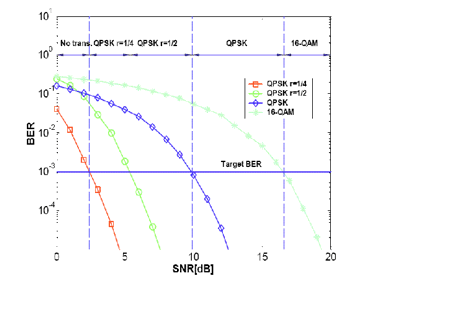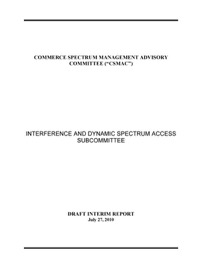Your Blogger's Students Would Get a Failing Grade for a Statement Like This; Why is it in an NTIA/CSMAC Draft that has been Approved?
“Some technologies, such as those employing code division multiple access (CDMA) techniques or those employing turbo error correction coding and hybrid retry mechanisms, such as LTE and WiMAX, are designed to operate at negative SNR but regardless, the throughput and capacity of a channel is proportional to the available SNR.” Draft Interim Report of Interference and Dynamic Spectrum Access Subcommittee, Commerce Spectrum Management Advisory Committee, 7/27/10 (p.28)
The above quote is from the draft of the NTIA Commerce Spectrum Management Advisory Committee’s Interference and Dynamic Spectrum Management Subcommittee that was approved “subject to edits” at the 7/27/10 CSMAC meeting in Boulder CO. It was also on p. 25 of the draft presented at the 5/10 meeting. (The final version of this report has not yet been posted on the CSMAC web site so more editing is possible before finalization.)
The CSMAC charter states that that the
“Committee will recommend approaches and strategies to ensure that the United States remains a leader in the introduction of new wireless technologies, while at the same time providing for the expansion of existing technologies and ensuring that the country’s homeland security, national defense, and other critical needs are satisfied.”
As we have written previously, the tone of the reports to date have focused on protecting incumbents from new entrants and putting as many burdens as possible on innovators. “Expanding new technologies” has not received much attention.
But the point of this posting is not the balance of power between incumbents and innovators. Some issues in spectrum management are subjective and reasonable people could disagree on these. Such issues include things like
- the priority of difference radio services,
- what is acceptable/harmful interference,
- what is the best propagation model for a given environment,
- minimum protection distances between systems,
- use of probabilistic interference models vice worst case (MCL) geometry, etc.
But as a prominent telecom lawyer once told me, “some problems actually have answers”. The quote above is one of those. The answer here is simple: the quote above is technical nonsense!
Your blogger has taught at George Washington U. and MIT and was recently appointed to the adjunct faculty at Virginia Tech. (More soon on the course he will teach there in the Spring Term.) Any student submitting such a statement in a term paper would fail the course.
A first clue that something is wrong can be found by just Googling “hybrid retry mechanism”, as shown below. (Bing could not find any use of this phrase either.)

Now for the ability of LTE and WiMAX to “ to operate at negative SNR” (signal-to-noise ratio) that is, where the desired signal is weaker than the background noise or interference - this is total nonsense that should be obvious to anyone who has studied communications theory in the past 30 years. LTE and WiMAX are both OFDM systems - as is the European DTV standard, DVB-T. WiMAX has several modulation schemes and picks the best one for a given location. Their performance as a function of SNR is shown below:

WiMAX bit error rate (BER) vs. signal-to-noise ratio (SNR)
All need positive SNR to meet the BER (bit error rate) target! This is not “rocket science”. This is stuff taught to undergraduate electrical engineering students (and probably should be on amateur radio tests if the testing were not controlled by Social Security recipients). If LTE and WiMAX could operated at negate SNR, wouldn’t you think that DVB-T, its technical cousin, could also? Therefore wouldn’t DVB-T be better than the US’ ATSC DTV? It really isn’t difficult to see how foolish this statement is.
Thee sentence in question was not an last minute addition to the 7/10 CSMAC draft. As stated above, it was also on p. 25 of the draft presented at the 5/10 meeting. So 2 months after this first draft was presented, the CSMAC approved the report “subject to edits” without any dissent within the committee. Does anyone read this stuff?
Your blogger has urged both FCC and NTIA to balance their advisory committee with technical people with significant peer recognition such as being IEEE fellows or members of the National Academy of Engineering. Clearly NTIA did not listen and this is an example of the result.
NTIA has to reappoint people to the CSMAC soon and FCC is still contemplating TAC nominations. Yes, the TV broadcasters and the major cellular carriers deserve a place at the table, but the price of admission should be sending someone who is technically competent in contemporary communications technology. Do we really need advisory committees made mostly of lobbyists with little or no technical background?
Spectrum policy is too important to be left mostly to lawyers.
[Note: I attempted twice to contact a senior technical staffer at MSTV,
the organization of subcommittee chairman Donovan and
“the recognized industry leader in broadcasting technology and spectrum policy
issues”, to ask about this sentence in the report.
Neither inquiry was returned.]
GNTEBHXBDBW2




![Validate my RSS feed [Valid RSS]](valid-rss-rogers.png)

